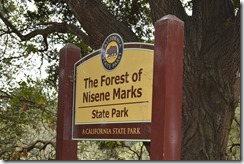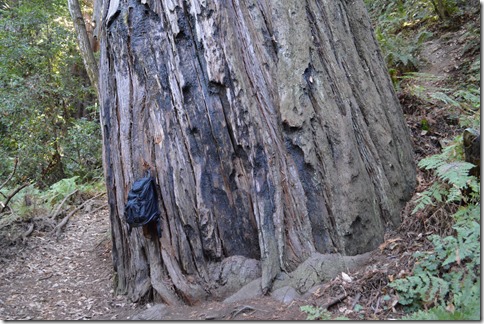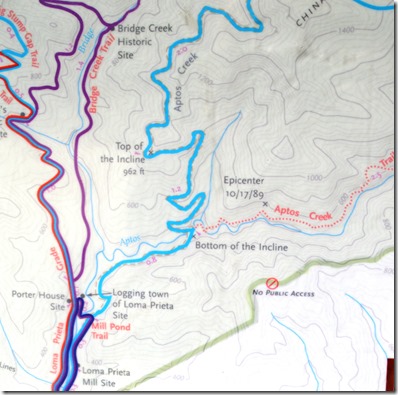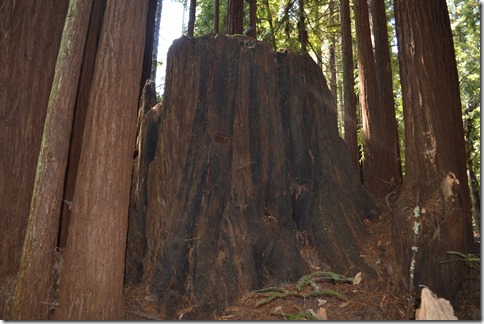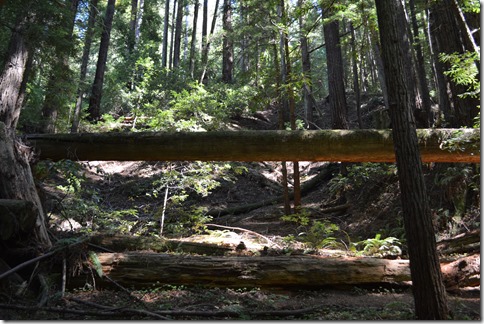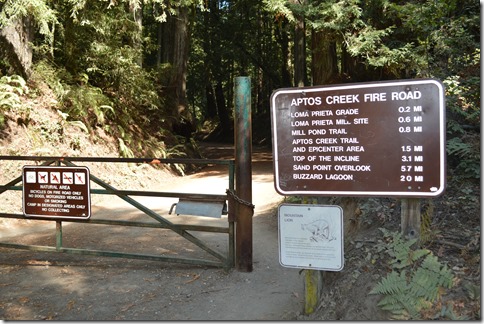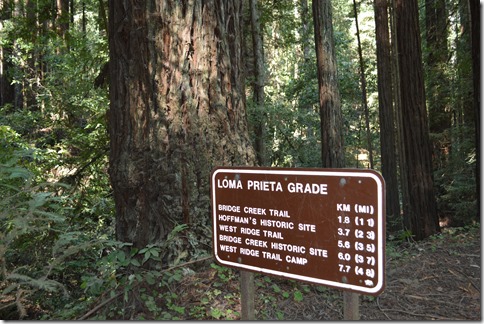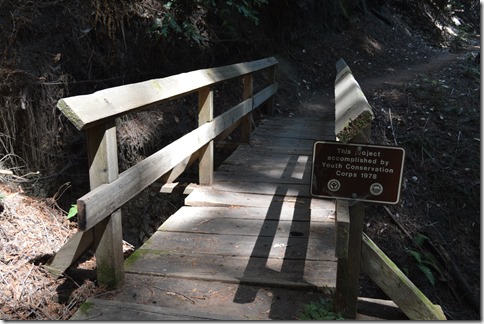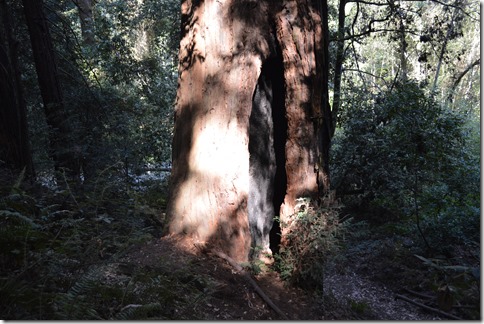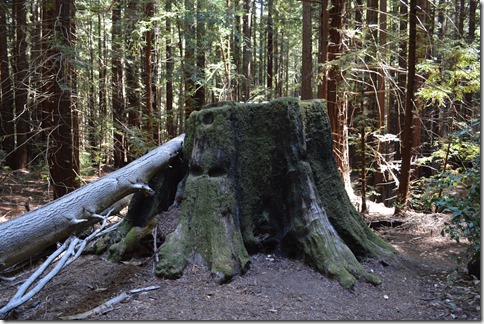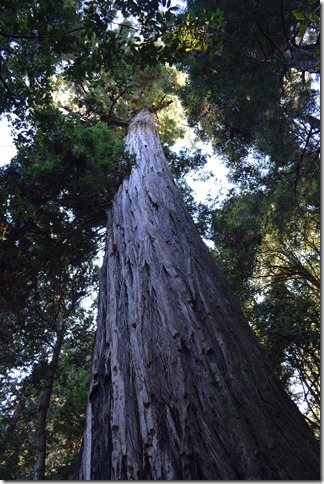Who thinks to hike a coastal redwood forest where nearly all the ancients were toppled over 100 years ago?
Proximity of The Forest of Nisene Marks State Park to Highway 1 in Aptos, California ten miles south of Santa Cruz made this park a closer getaway from Monterey than driving to California’s first state park established to save the old growth coast redwoods at Big Basin Redwoods State Park another 30 miles north, deep in the Santa Cruz Mountains.
Nisene Marks was the nature-loving mother of a Salinas area rancher family. The transfer of 9,700 acres of mostly second growth redwood forest land by the family to the state of California in 1962 with the aid of The Nature Conservancy allowed the establishment of The Forest of Nisene Marks State Park in 1963.
The old-growth redwood trees in the park area were logged between 1883 and 1923 when the hillsides and valleys all along the coastal mountains of the Santa Cruz range were heavily harvested for valuable timber. Some redwood giants had lived more than 1,000 years surviving fires, storms, earthquakes and droughts. In less than 50 years from 1850 to 1900 most of the old growth ancients had been felled that for millennia had covered much of the Santa Cruz Mountains stretching about 70 miles from Monterey Bay northward nearly to San Francisco.
The Advocate Tree in The Forest of Nisene Marks State Park is estimated to be over 1,000 years old and is one of the few remaining ancient redwood trees in the park. Old Growth Trail is also one of the shortest hikes with the tree’s location about 0.5 miles from the State Park entrance station parking lot. Nisene Marks State Park has over 30 miles of trails.
Ancient redwood trees that had survived the initial onslaught on trees felled for construction needs during the Gold Rush era could not withstand the arrival of the railroads into interior valleys of the Santa Cruz Mountains. Aptos Creek Fire Road in Nisene State Park was originally a seven mile railroad line built in 1883 to reach the virgin forests of these creek valleys outside Aptos.
Chinese laborers were the predominant workers constructing railway lines across California in the 1870s to 1890s for passenger travel and freight. Private rail lines were constructed by lumber companies throughout the redwood habitat of coastal central and northern California to transport the giant trees logged over the decades. Fewer than 5% of old growth coast redwood trees existing in 1850 survive today.
The main attraction for visitors from outside the local area within the boundaries of The Forest of Nisene Marks State Park is the epicenter of the October 17, 1989 Loma Prieta earthquake. Loma Prieta Peak at 3,786 ft. is the highest peak in the Santa Cruz Mountains. The 6.9 Loma Prieta earthquake of 1989 caused the freeway collapse in Oakland killing dozens, the San Francisco-Oakland Bay Bridge span collapse and the Marina District fire in San Francisco. Nearby Watsonville and Santa Cruz in Santa Cruz County were only 15 miles from the epicenter and both cities suffered intense damage of downtown commercial buildings.
The Forest of Nisene Marks these days is mostly restored with second growth redwoods in a land that was once filled with giants.
My focus for this hike was a walk under the redwood skies along the Loma Prieta Grade trail.
The big trees in these mountain valleys were cut down in the 1880s and 1890s when private railroad lines into the mountains allowed mill owners to transport the old growth giants on rail cars to the coast.
While the giant redwoods may be gone, there is actually more wood in many of these redwood forests today with higher density second and third growth trees rising up in the past 130 years. Where once there was a giant redwood, the Nisene forest today reveals fairy rings of trees that have sprouted around the old stumps.
A young redwood tree growing out of the old growth stump.
Fairy rings are the name given to second growth redwood trees surrounding a parent tree stump. A remarkable feature of coast redwoods is their ability to reproduce asexually. New trees tend to sprout from the roots of fallen trees and rise in a ring around the parent tree. New redwoods can grow over 60 feet in their first 20 years. A new tree can even grow from the stump of a logged old growth redwood.
Not all redwoods live for one thousand years or more. Over centuries many massive redwoods fell in the forests. Slow decay of fallen redwood trees was one of the major obstacles to early travel and settlement of the Santa Cruz Mountains and other areas of the California redwood coast region. Large numbers of massive redwoods lying on the ground in various stages of decomposition could block 200 to 300 feet of forest floor with a single tree.
Fallen redwood logs may cross ravines flowing with water in the rainy season. Natural bridges if you dare. Hard falls if you slip, trip or lose your balance.
The long straight grain of old growth redwoods produced valuable timber beams for building and bridge construction. The redwood’s innate resistance to water and insect destruction meant even fallen trees were heavily harvested for all sorts of decay resistant wood products like stakes, railroad ties, kindling, and fuel.
Many railroad ties are still visible today on the hiking trails in the Forest of Nisene Marks State Park.
Aptos Creek Fire Road was the former railroad line from the town of Aptos into the redwood canyons around Loma Prieta. The Loma Prieta 1989 earthquake epicenter is 1.5 miles from the upper parking lot in the Nisene Marks park. Bicycles are allowed on the Aptos Creek Fire Road, but not on the narrow hiking trails like Loma Prieta Grade.
Loma Prieta Grade hiking trails in The Forest of Nisene Marks State Park.
Five miles from Aptos on the mountain trails the quiet was rarely broken by unnatural sounds. The trail is clear, but narrow hiking in spots. Old rail ties and tree roots jut up and provide trail obstructions to watch out for when walking on some ledges with 50 to 80 foot drops down into the forest ravines below.
This 1978 sign reminded me that I spent part of 1977 working in a Youth Conservation Corps crew 50 miles south of Aptos in the Santa Lucia Mountains of Monterey County cutting fire breaks with axes and saws on the mountain ridges. The Marble Cone fire in August 1977 put our crew in Big Sur working a fire base camp at Andrew Molera State Park for about five weeks.
Fires burn the core of old redwoods, yet the large trees survive.The resulting cavernous hollow in the base of the ancient redwood trees are referred to as goosepens due to their use by early California pioneers as convenient places to keep domestic fowl penned up inside a tree cage.
The Advocate, a 1,000 year old growth redwood tree near the entrance of Nisene Marks State Park has an 18 ft. high goosepen which may have been the tree’s impediment resulting in this 250 feet tall ancient tree being spared by loggers a century ago.
Walking these hillside trails on a sunny 75 degree September day in the shade of trees requires concentration to the ground when hiking, yet upward in the crown cover of filtered sunlight is a colorful scene. The second growth forest has far more trees than an old growth forest where less light reaches the ground to support new redwood tree growth.
Young redwood crowns allow light to reach more trees.
Loggers cut the old growth redwoods typically around 4 to 6 feet from the ground where the trunk grew straight and tall with a consistent circumference. Springboard holes drilled into the giant redwood trunks a few feet above the ground allowed planks to be inserted into the redwood tree for the loggers to stand on while cutting the tree trunk.
Springboard holes are visible in this old growth redwood stump.
My backpack at the base of this stump seen from the opposite side reveals the size of this old growth redwood tree stump.
Late summer means creek water flow is at a trickle in these parts of the Central Coast where the last rain storm occurred some four months ago in May in what has been low rainfall seasons for the past two years.
The Forest of Nisene Marks State Park is an ecosystem undergoing restoration with 50 years of park trail maintenance after a century of commercial logging and exploitation of its natural resources. This second growth coast redwood forest near Santa Cruz is a place to walk beneath redwood skies on forest trails. Nisene Marks is near urban centers, yet far enough away from the crowds to provide a redwood park wilderness experience for the public.
Car parking is $8 per day in the park and a few campsites are available within park grounds for $5 per night. There are several locations with picnic facilities. The only toilet is located at the park entrance. The park is open from 6am to sunset year round.
The Advocate old growth coast redwood is more than 250 feet tall and 45 feet in circumference measured a few feet above the ground. This 1,000+ year old ancient tree is near the Forest of Nisene Marks State Park entrance gate. The Advocate tree is probably a survivor of the 19th century harvest of the redwood giants in the area due to its bend (seen in this photo) and large goosepen burn scar at the base.
Once there were giants living all over these hills and canyons surrounding Loma Prieta in the Santa Cruz Mountains where the old redwood forests touched the sea of Monterey Bay.
There may be redwood giants growing here again in 500 years.
The mission of Save the Redwoods League is to protect and restore redwood forests and connect people with their peace and beauty so these wonders of the natural world flourish.
Save the Redwoods League established in 1918 to protect the natural resource of old growth California forests for the public and the natural environment. The work continues today and here are current forest preservation projects being worked on by Save the Redwoods League. Many of these projects need funds to help purchase valuable timber lands from private owners. Around 20% of all remaining old growth forest in California is still in private ownership.
Ric Garrido, writer and owner of Loyalty Traveler, shares news and views on hotels, hotel loyalty programs and vacation destinations for frequent guests. Check out my page of collated current hotel promotions.
Follow Loyalty Traveler on Twitter and Facebook and RSS feed or subscribe to a daily email newsletter on the upper left side of this page.


